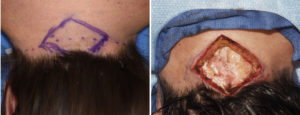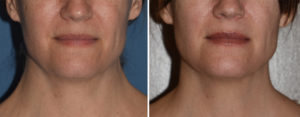Background: A webbed neck, also known as a ptergyium colli, presents as wing-like skin extensions around the sides of the neck that extend down to the shoulders. One of its classic signs is that the occipital hairline follows down along the webs creating an m- or inverted v-shape to the hairline from the back. Significant neck webs are always syndromic and have well known associations with Turner’s, Noonan’s or Klippel-Feil syndromes.
But neck webbing is not always associated with a specific syndrome and I have seen numerous webbed neck patients that do not have any syndromic association or any other bodily symptoms. Their neck webbing appears to be an isolated finding or possibly they have mosaic Turner syndrome (absence of X chromosome in some cells) which results in milder symptoms than other types of the disorder.
In the treatment of neck webbing, the classic teaching is that the only effective treatment method is the use of Z-plasties along the line of the neck webs. While this is effective the Z-plasty scars would not be viewed as good tradeoff for the neck webs. I have never performed Z-plasties for neck webbing and never would. The scars are simply not acceptable particularly in milder forms of neck webbing.
Case Study: This middle-aged female presented with mild but visible neck webbing that she had her entire life. She did not have Turner’s or any other known syndrome and she was otherwise normal in every aspect of her physical and sexual development.


The old concept of treating neck webbing by Z-plasties should be abandoned for a posterior midline approach using skin excision and fascial release and plication. While this approach also creates a scar , it is placed in a location that has no aesthetic liabilities even if the scar widens.
Highlights:
- Webbed neck deformities are most commonly associated with Turner’s syndrome but smaller webbed necks can occur in isolation.
- Webbed neck correction depends on both skin excision and fascial plication on the back of the neck.
- Correction of the webbed neck results in a vertical scar at the bottom of the occipital hairline.
Dr. Barry Eppley
Indianapolis, Indiana




